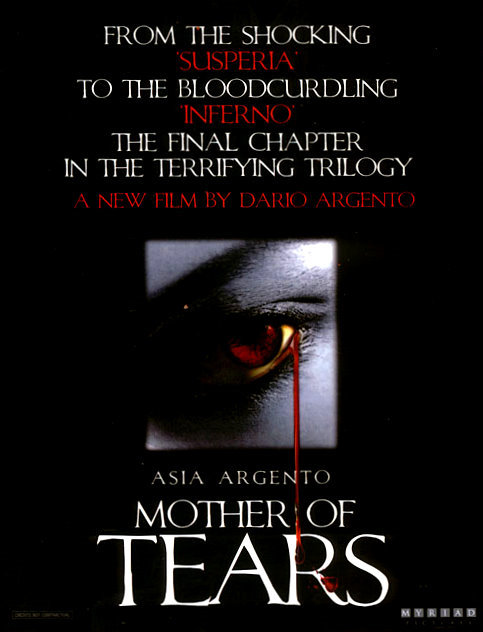Mater Lachrymarum, Our Mother of Tears. She it is that night and day raves and moans, calling for vanished faces. She stood in Rama, when a voice was heard of lamentation – Rachel weeping for her children, and refusing to be comforted. She it was that stood in Bethlehem on the night when Herod’s sword swept the nurseries of Innocents […] Her eyes are sweet and subtle, wild and sleepy by turns, oftentimes rising to the clouds; oftentimes challenging the heavens.
– Thomas De Quincey, Suspiria de Profundis
I, Varelli, an architect living in London, met the Three Mothers and designed and built for them three dwelling places. One in Rome, one in New York, and the third in Freiburg, Germany. I failed to discover until too late that from those three locations the Three Mothers rule the world with sorrow, tears, and darkness. Mater Suspirorum, the Mother of Sighs and the oldest of the three, lives at Freiburg. Mater Lachrymarum, the Mother of Tears and the most beautiful of the sisters, holds rule in Rome. Mater Tenebrarum, the Mother of Darkness, who is the youngest and cruelest of the three, controls New York.
– From “The Three Mothers” in INFERNO
 Cinematic horror has a relatively easy time portraying the visceral, but there is more to the genre than Grand Guignol gore. There is also a metaphysical aspect that might, in its simplest formulation, be distilled down to a fairy tale battle between opposing forces of Light and Darkness, Good and Evil. This second aspect of the horror genre is harder to film; after all, how do you photograph an abstraction? (It is obviously much easier to film a knife sinking into a torso.) With SUSPIRIA and INFERNO, Italian filmmaker Dario Argento took a stylized (metaphoric) stab at conveying the unseen presence of “magic…all around us, everywhere,” using deliberately artificial lighting schemes and eccentric camera angles (buildings reflected in puddles, people reflected in buildings) to suggest a parallel world of strange and sinister forces lurking somewhere behind what we call “reality.” THE MOTHER OF TEARS, the concluding chapter of Argento’s “Three Mothers” trilogy, dispenses with the overt stylization of its predecessors (which seemed to take place in some kind of adult fairy tale) in favor of a sobering dose of realism. Ironically, this more prosaic approach turns out to be even more effective at portraying a profound metaphysical horror lurking behind the physical violence on screen. Evil is no longer confined to one of Varelli’s architectural monstrosities; it walks the streets of Rome by daylight, infecting those it touches, creating a eruption of senseless violence that seem to signal the coming of the Apocalypse. Continue reading “Mother of Tears (2007) – Film Review” →
Cinematic horror has a relatively easy time portraying the visceral, but there is more to the genre than Grand Guignol gore. There is also a metaphysical aspect that might, in its simplest formulation, be distilled down to a fairy tale battle between opposing forces of Light and Darkness, Good and Evil. This second aspect of the horror genre is harder to film; after all, how do you photograph an abstraction? (It is obviously much easier to film a knife sinking into a torso.) With SUSPIRIA and INFERNO, Italian filmmaker Dario Argento took a stylized (metaphoric) stab at conveying the unseen presence of “magic…all around us, everywhere,” using deliberately artificial lighting schemes and eccentric camera angles (buildings reflected in puddles, people reflected in buildings) to suggest a parallel world of strange and sinister forces lurking somewhere behind what we call “reality.” THE MOTHER OF TEARS, the concluding chapter of Argento’s “Three Mothers” trilogy, dispenses with the overt stylization of its predecessors (which seemed to take place in some kind of adult fairy tale) in favor of a sobering dose of realism. Ironically, this more prosaic approach turns out to be even more effective at portraying a profound metaphysical horror lurking behind the physical violence on screen. Evil is no longer confined to one of Varelli’s architectural monstrosities; it walks the streets of Rome by daylight, infecting those it touches, creating a eruption of senseless violence that seem to signal the coming of the Apocalypse. Continue reading “Mother of Tears (2007) – Film Review” →


